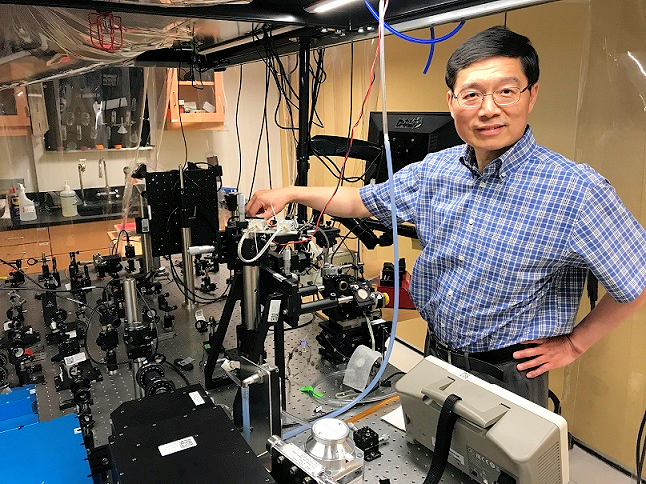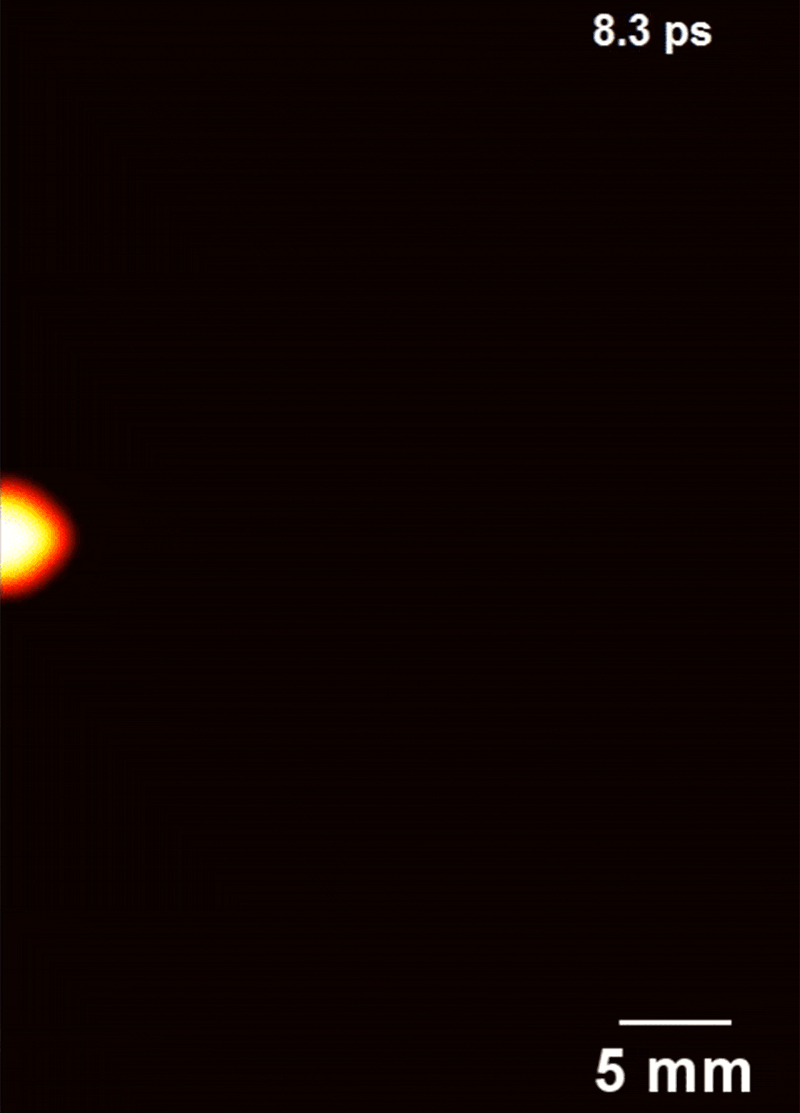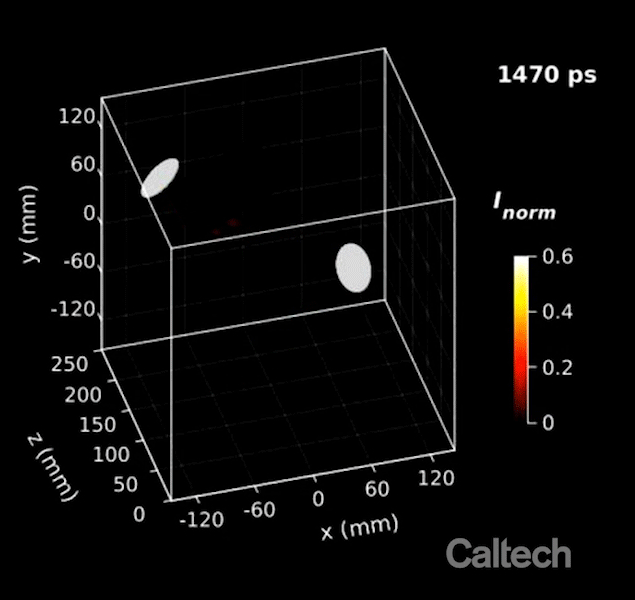Photography is a hobby for few, and necessity of many. Cameras and photography as a whole, have evolved with great intensity since past 3-4 decades. With its advancement in smart phones, cameras have taken huge leaps and reached new possibilities to capture things differently and in a more detailed way. One of the major factors, deciding the performance of camera is, frames per second (FPS). Higher the FPS rate, more the information will be processed. At the same time, it also improves how it is processed and at what speed it is processed.
Recently, in this quest to build ever-fast cameras and breaking records, California Institute of Technology (Caltech) showed some astonishing results. Caltech’s Lihong Wang has developed technology, termed as ultrafast camera, which can capture 3-D movies at 100 Billion frames per second.
This insane technology can reach blistering speeds of 70 trillion FPS, which is fast and smooth enough to see light travel. It is more like your cell phone camera, but producing flat images instead. Evidently, this new technology can capture ultrafast three-dimensional videos & may help to solve some scientific mysteries, unknown since years.
So, let us capture more (know more) about the technology and its amazing captures.
Note: While reading, don’t feel sleepy. We are capturing your every single movement at 100 Billion FPS.
Knowing the Technology in ultrafast way:
Let me quickly explain what is frames per second (FPS), and what is its importance here. Basically, it is the rate of frames (or consecutive images) appearing on display. So, if consider 30 fps. Then, 30 frames in a single second of video will appear. Same way it goes with 60 fps, 120 fps (and indeed for 100 billion fps too). Higher the fps rate, smoother the video will be. Interestingly, human vision has only 10-12 fps capturing rate, and beyond it, everything is in motion.
Here, Wang has developed new technology, which he iterated as;
“single-shot stereo-polarimetric compressed ultrafast photography,” or SP-CUP.
In CUP technology, all the frames of entire video are captured in one single action, without repeating the event. This makes the technology extremely quick. Also here, Wang added that, he has tried to bring out one extra thing, which actually makes the whole technology unique.

When we normally look around, see things, experience things in our surroundings, we perceive that some objects are closer & some are farther away. This is known as depth perception. It is possible, because of our two eyes, each of which observes their surroundings in slightly different angle. Lastly, brain combines the information from these both images into a single 3-D image.
The camera developed here, works in essentially the same way. SP-CUP has only one lens. But interestingly, it functions as two halves which provide two different views with an offset. So basically, these two channels mimic our eyes pretty well. Here, computer that runs SP-CUP does the part which our brain does with signals received from the eyes. It processes data obtained from these two channels, into one three-dimensional movie.

(GIF: GadgetZZ)
Thus here, Wang’s camera has gone one step further than just recording videos at insane fast speeds (Ya! Ya! 100 B FPS). Camera can now record videos in three dimensions, at the same incredible fast speed.
Super ability of Ultrafast Camera: Capturing the unwatchable
With its ability to see and capture things in three dimensions, SP-CUP has one incredible ability that no human has. To see the polarization of light waves.
Consider a string attached to two rigid-supports. If string is pulled upwards or downwards, string vibrates vertically. If plucked sideways, it vibrates horizontally. Interestingly, visible ordinary light vibrates in all directions. However, polarized light is modified in such a way, it vibrates only in one direction. This can also occur naturally. Yet, artificially it can be done by using polarizing filters.
Day-to-day life example of this are; LCD screens (pretty out-dated) or polarized sunglasses or camera lenses even. It is used to detect hidden stress in materials and 3-D configuration of molecules, at scientific level.

Combination of high-speed 3-D imagery, with all the polarization information obtained from the computer, makes it a very powerful tool. It can be applicable to wide range of scientific problems.
For starters, consider a phenomenon that we all have witnessed in our childhood. Everyone remember soap-bubble, right? When we tried to burst it with our tiny little fingers, it was soothing and we enjoyed it a lot. But scientifically, when bubbles collapse rapidly after their formation, they emit a burst of light. This is because, when it bursts rapidly, its interior reaches such high temperatures, that it emits light in the form of energy.
Similar phenomenon is visible when sound waves, subjected in water or liquid, create tiny bubbles. This is a physical phenomenon – Sonoluminescence (probably never thought this deep while bursting the bubble)
This all tantalizing phenomena occur very rapidly and mysteriously. We need such ultrafast camera which could help understand and process all this, which is considered one of that great mysteries in physics.
Synergizing the imaging technology
Talking about great mysteries of physics, simultaneous and efficient ultrafast recording of multiple photon tags was unachievable; until the ultrafast camera. This majorly can contribute to high dimensional optical imaging and characterization in various fields (quantum computing even). This optical imaging is indispensable to maximize and extract information carried by different photon tags. Ultrafast camera can be ubiquitously used in various fields like biomedicines, agriculture and electronics.
Till now, high-dimensional imaging involved capturing either a 1-D column or 2-D array or slice. This inherently suffers low measurement efficiency and lack of information. In past decades, different techniques were developed at a rapid rate, to overcome this. Yet, existing approaches could measure different combinations of photon tags. So, much Detailed study was possible and 3-D models were enabled, apart from 2-D spatial information.
But this ultrafast camera, took interest of many scientific communities. With its single-shot temporal imaging & high dimensional optical imaging this technology is par excellence. Its novel ability, to capture photon’s time of arrival, without repeating the measurement is also notable. This opens new paths in understanding underlying and unidentified mechanisms and phenomena in physics, chemistry and biology. Especially, events which are manifested non-repeatable or difficult-to-reproduce events, can be studied with precision and efficiency.
Capturing things at such high speed, make us realize, how fast the mother nature functions
& how slow we (as humans) are, determining it.
—OSD




I just like the valuable info you provide to your articles.
I will bookmark your blog and check once more right here frequently.
I’m quite certain I will learn many new stuff right here!
Best of luck for the following!
This post is in fact a pleasant one it assists new internet viewers, who are wishing for blogging. Phyllida Adrian Cristen
I am genuinely delighted to read this blog posts which contains plenty of helpful data, thanks for providing these kinds of data. Yvette Niel Stinson